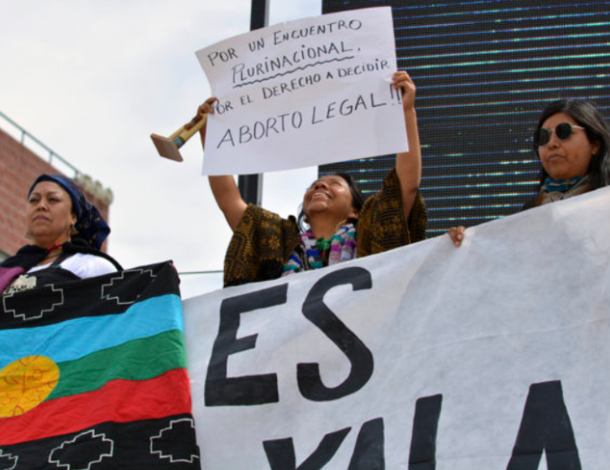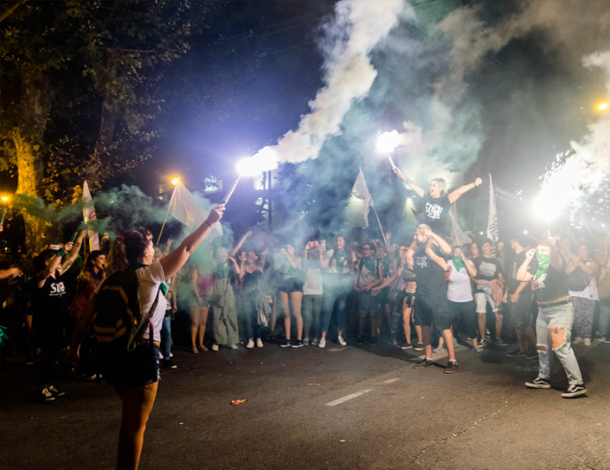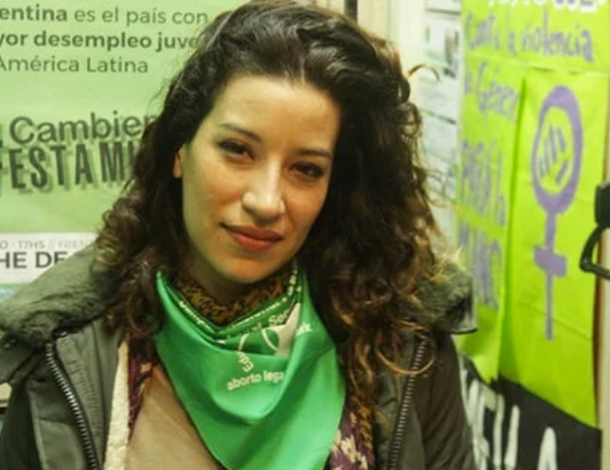This article is the first in a new series coordinated by AWID on feminist movements’ autonomous resourcing around the world.
Activist and sociologist Victoria Tesoriero provides moving examples of how feminists in Argentina are using autonomous resourcing as part of their mass mobilizations for reproductive rights. Their efforts have reverberated across the nation and the world, from the “Green Wave” for safe and legal abortion in Argentina to demonstrations at international spaces such as the Cannes Film Festival.
In light of the continued assault on reproductive rights globally, including several recent sweeping anti-abortion laws in the U.S., this article is a timely exploration of the ways in which resourcing can enable powerful political action.

The women’s movement in Argentina is currently one of the strongest social movements in our country – perhaps the strongest. The 2018 abortion legalization debates, mobilized over one million people on different dates: March 8, June 13 and August 8.
Argentina is a middle-income country, but is not a priority for international cooperation, nor for funding agencies. In this context, women have found alternative sources to self-finance, linked to our activism and the advance of our causes.
The purpose of this article is to share the experience of different Argentinian women’s movements regarding self-financing and resource generation, showing how “self-generated resources” can serve as a feminist strategy for autonomy.
In this article, we will examine two concrete experiences that rely on different self-generated resourcing strategies: the National Women’s Convening (ENM, Encuentro Nacional de Mujeres) and the National Campaign for the Right to Legal, Safe and Free Abortion (Campaña Nacional por el Derecho al Aborto Legal, Seguro y Gratuito) – two key spaces for organizing and movement building that helped create steadier collaboration and brought together activists from across different generations.
The National Women’s Encuentros
After the return of democracy in Argentina, the National Women’s Encuentros are the largest organizing effort. Since 1986, and to this date, they are still the largest organizing space for the women’s movement, given the breadth they are able to convene. Year after year, they bring together thousands of activists from across the country who gather to debate the agendas, activities, strategies and alliances of the movement in general and of feminism in particular. These meetings began when a group of feminists who had attended the United Nations Third World Conference on Women in Nairobi in 1985 took the initiative to start organizing national convenings, or encuentros, where the demands and realities of a diverse range of women could be discussed in a horizontal way.
The first National Women’s Encuentro was held in the city of Buenos Aires and attended by roughly a thousand women from across the country. Since then, in each convening the participants decide where the next encuentro will be hosted, rotating through all of the country’s provinces. The encuentros are held annually, during a long weekend in October.
The discussion about resources has been present since the very beginning of the ENM, embedded in broader debates about the autonomy of the women’s movement and women’s organizations, not only in regard to funding agencies, but also to political parties. It was decided that the encuentros would be self-funded, in that every woman who wished to attend would arrange funding for her own travel.
Each year, women from the city in which the encuentro will take place form an Organizing Committee in charge of speaking with the local government to secure use of public spaces, schools, and other available buildings for workshops, meetings, and free accommodation for the women. There is a very low fee to attend that covers meals and materials, for the current encuentro and even part of the next one. Throughout the year, women organize in their own towns and cities to gather the money they need for tickets and other travel expenses. They use a range of different strategies, from holding “peñas,” which are traditional dinners with folk music where people come to eat and drink and whose profits pay for minibuses for travel to and from the encuentro. Women also organize raffles and yard sales, where second-hand clothing is sold to raise funds.
Such self-resourcing guarantees the ENM’s autonomy, which is highly valued by the Argentinian women’s movement. Today, the National Women’s Encuentros are attended by about 100,000 women each year.

The National Campaign for the Right to Legal, Safe and Free Abortion
The ENM held in Rosario, Santa Fe in 2003 was a turning point. Ten thousand women marched under the slogan, “Contraception so we don't have to abort, legal abortions so we don't have to die”. The following year, during the ENM in Mendoza, the movement agreed to carry out a three-month campaign known as the National Campaign for the legalization of abortion, starting May 28 (International Day of Action for Women’s Health), and ending on September 28 (International Safe Abortion Day). Once again, participants came together around the issue of abortion legalization, becoming the main demand and culminating in a massive rally of twenty thousand women demanding “legal and safe abortion”.
The National Campaign prepared a bill to decriminalize and legalize abortion based solely on a woman’s choice up until the 14th week of gestation. Since then, year after year more organizations from a range of profiles have joined the demand for legal abortion. Building such alliances has always been a fundamental strategy for strengthening feminist movements, but in this case it also played a role in resourcing, as organizations within the Campaign offered distinct contributions. For example, different groups provided travel support, rooms for meetings, stages and sound equipment for public demonstrations and donations to make green scarves, a symbol for the struggle for the right to abortion in our country.
The Campaign grew by strengthening alliances with many other organizations such as feminist groups and trade unions, universities, political parties and a variety of grassroots groups. During the 2018 parliamentary debate, trade unions provided the tents where press conferences and roundtables took place and also helped by contributing a stage and the sound system. Other organizations contributed low-cost t-shirts and screens used for the live streaming of the parliamentary session. Meetings to organize rallies were held in universities, in rooms of the National Congress or in the offices of some of the member organizations of the Campaign. Internacional Feminist funders supported with a modest contribution of resources to produce materials and to make scarves. Organizations also contributed with specific resources for particular initiatives, events, and mobilizations. Although useful, these external resources alone were not sufficient, which led us to self-finance.
In 2018, after decades of struggle, the abortion debate made it into the National Congress for the first time. On June 13 and August 8, over one million people mobilized to demand the right to abortion in what was called the “green tide”. Building alliances among different organizations proved to be the most effective strategy for sustaining the expenses required for mobilization. Throughout the year, the need to have resources for public demonstrations, materials, and travel was imperative.

These two experiences illustrate a distinct trait of the Argentinian case, in which the women’s movement has learned the significance of self-funding.
Though very difficult at times, self-funding is crucial to bring visibility to our demands and to organize, particularly when we need to take swift action and immediately require resources. In many circumstances, not having conditions placed on how or where to use funds makes it possible to be flexible with expenses as they arise. While there are actions that cannot be carried out due to a lack of funds, many others can. Although under some circumstances the lack of resources poses a limit to growth, at other times that limit can be overcome.
In the case of the National Women’s Encuentro, self-resourcing is symbolic of the encuentros themselves and places the focus on women’s autonomy as a form of political capital. We have learned to work with limited resources and value the ability to organize ourselves quickly to mobilize funds, relying on alliances with other organizations, on contributions from international funders and on our own creativity to do whatever is necessary in our struggle for our rights.
2224x1253.jpg)